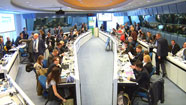On 5 April 2016 the JRC presented the interactive and collaborative online European Energy Efficiency Platform. This beta platform is conceived to fill the gap opened by scattered data and fragmented knowledge resulting from a rapidly growing energy efficiency market. It is expected to be both a one-stop shop for information retrieval and a meeting point for experts to exchange data and reduce redundant activities.
European LED Quality Charter

 The European Commission together with several national governments, energy agencies, public and private organisations/industries is promoting the end-use energy efficiency in lighting through several instruments as a key component of the EU energy policy and the common goal of reducing climate change.
The European Commission together with several national governments, energy agencies, public and private organisations/industries is promoting the end-use energy efficiency in lighting through several instruments as a key component of the EU energy policy and the common goal of reducing climate change.
In EU, the total domestic lighting consumption is around 86 TWh and it is predicted to raise to 102 TWh by 2020 due to growing welfare especially in some countries and rapidly increasing number of lamps per home. LED lamps efficacy and luminous characteristics are improving very rapidly. In the future, LED lamps are expected to deliver substantial energy savings. LED lamps last 5-25 times as long as the traditional lamps.
GLS and some halogen lamps are about to be phased out due to EU regulation (Eco-design). In many cases, LED lamps are a valid retrofit solution. During this decade it is expected that LED lamps will cover nearly all types of lamps. At present, LED lamps are nearly not used for indoor lighting in the residential sector but the market penetration is starting.
The challenge is to retrofit incandescent lamps with LED lamps of good quality – alternatively users will install mainly new halogen lamps with only slightly lower energy consumption. The barriers for this development are actual high prices for LED lamps of good quality and the variation in performance of LED sources in the market is far too large. Many customers may have bad experience with use of LED lamps and that will threat consumer confidence in LED lighting performance and savings. This might give a delay in market acceptance and a slowing down of the LED penetration rate.
The availability of good quality products is thus most essential along with information about the high energy efficiency and the savings for the consumer. Since the actual price of LED lamps of good quality is high, governments, municipalities and/or utilities may subsidise the LED lamps. A LED quality charter is needed in these activities, to assure public money is spent on lamps delivering real savings.
More than 20 years ago when the CFL product was introduced at the market the situation was quiet similar. After buying the first CFLs many consumer were very dissatisfied and rejected the technology. It took many years and a lot of work to overcome the barriers created during the first years at the market. It is very important not to repeat these failures when the LED is introduced at the market. Development of the market for LED lamps is thus very important to increase energy efficiency and reduce CO2 emissions in the European Union. Standards and Eco-design regulation are coming within the next year. The role of the European LED Quality Charter is to set a important voluntary requirements for white LED lamps (not covering LED chips, modules or luminaires) that can be used now by governments, municipality, energy savings, utilities and other active parties to ensure the quality of LEDs on the market.




To quote this article use the follonwing format: